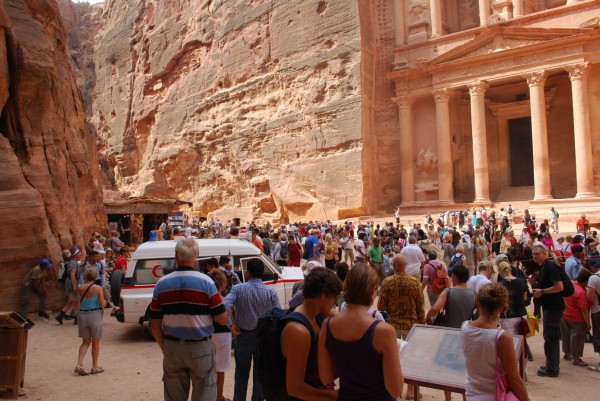
Petra, which is situated about 50 miles south of the Dead Sea in territory once dominated by the descendants of Edom, was an important crossroads between Arabia, Egypt and Syria-Phoenicia. It is one of the world’s most famous archaeological sites and one of the most surveyed. (Photo by Jean Housen)
“Edom will become an object of horror; all who pass by will be appalled and will scoff because of all its wounds. … so no one will live there; no people will dwell in it.” (Jeremiah 49:17–18)
Archaeologists have discovered a massive ceremonial platform hiding in plain sight at the popular tourist destination of the ancient ruins of Petra, Jordan, a major city of the Edomites — the descendants of Jacob’s brother Esau. (Genesis 36:43)
American archaeologist Sarah Parcak, who is a remote sensing expert, Egyptologist, National Geographic fellow, and the associate professor of Anthropology and director of the Laboratory for Global Observation at the University of Alabama, and Christopher Tuttle, the executive director of the Council of American Overseas Research Centers, used satellite imagery, aerial drones, and ground surveys to find the structure.
At 184 by 161 feet (about 51 by 49 meters), the platform is twice as large as an Olympic-sized swimming pool and has no other known parallels at Petra.
“It’s this very large platform that many of us have walked over for years, and probably didn’t even realize we were walking on it,” Tuttle said.
“We know it’s large, it’s significant, it’s important,” Parcak said. “Could it be used for religious purposes? Was it some sort of public administrative structure? I wish I knew.” (NPR)

Sarah Parcak analyzes infrared imagery collected from far above the Earth’s surface to identify hidden archaeology. As a satellite archaeologist she intends to bring about a new understanding of the past and to preserve and protect sites from looting.
A second platform, built on top of the base, features flagstones and staircase-supporting columns, with a “monumental” staircase on one side.
“A small 28-by-28-foot (8.5-by-8.5-meter) building was centered north-south atop the interior platform and opened to the east, facing the staircase,” writes National Geographic, adding that “it most likely had a public, ceremonial function, which may make it the second largest elevated, dedicated display area yet known in Petra after the Monastery.”
“Parcak noted that the platforms are located “just south of the city center, and archaeologists have missed this for 150–200 years.” This site, which is one of the most surveyed archaeological parks in the world, is located in the territory inhabited by the descendants of Esau. It is considered one of the greatest discoveries in Biblical archaeology because it is evidence of fulfilled Bible prophecy.
Because of the ongoing hostility of the Edomites to Israel, God declared their fate through the prophets.
The Prophet Obadiah foretold its destruction: “The pride of your heart has deceived you, you who live in the clefts of the rocks and make your home on the heights, you who say to yourself, ‘Who can bring me down to the ground? Though you soar like the eagle and make your nest among the stars, from there I will bring you down,’ declares the Lord.” (Obadiah 1:3–4)

This UAV image shows a platform hidden under the sand in Petra, Jordan. The platform was not clearly visible from the ground, but only images taken from above it revealed the shape. (Council of American Overseas Research Centers/I. LaBianca via AP)
Malachi 1:3–4 states, “Esau I have hated, and I have turned his hill country into a wasteland and left his inheritance to the desert jackals. Edom may say, ‘Though we have been crushed, we will rebuild the ruins.’ But this is what the Lord Almighty says: ‘They may build, but I will demolish. They will be called the Wicked Land, a people always under the wrath of the Lord. You will see it with your own eyes and say, “Great is the Lord—even beyond the borders of Israel!”’”
And Edom was given to the jackals just as Malachi stated. Even though the Nabateans overran Edom around 550 BC, it continued to be inhabited until about AD 4, when they mysteriously withdrew.
Petra essentially remained uninhabited and continues to amaze.
While the prophecies about Edom’s destruction have been fulfilled, Edom is also featured in prophecies about the end times.
According to the prophet Daniel, in the last days, the king of the north “will also invade the Beautiful Land. Many countries will fall, but Edom, Moab and the leaders of Ammon will be delivered from his hand” (11:41) — all cities of Jordan.
Though not explicitly stated in Scripture, many prophecy watchmen believe that the people of Israel will escape to Petra during the Great Tribulation when they face persecution from the anti-Messiah (see Zechariah 13:8–9; Revelation 12:6, 14).









